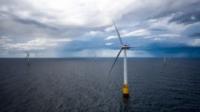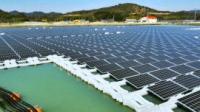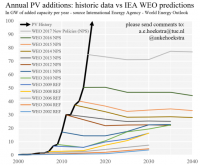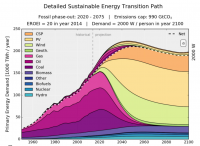Energy and Climate News
Energy and Climate News
This page is of external news items, with comments by Gordon Taylor
The tabs above lead to pages with documents by Gordon Taylor
2018-10-30 UK Floating Wind Could Support 17,000 Jobs & Generate £33.6 Billion In Value By 2050
A new report commissioned by the Crown Estate Scotland has found that not only does floating offshore wind have an important role to play in the UK’s plans to generate 50 gigawatts (GW) from offshore wind by 2050 but that it could support up to 17,000 jobs and provide £33.6 billion in added value.
2018-10-23 The EU has spent nearly $500 million on technology to fight climate change—with little to show for it
In a report to be published later today, the European Court of Auditors will say that the EU spent more than €424 million ($486 million) over the past decade decade fruitlessly trying to establish carbon-capture technology. The EU considers the technology crucial to hit its climate goals, which will require the union’s member states to reach net-zero emissions within decades.
2018-10-22 ‘Electrofuels’ that increase plane ticket price by 60% only way to clean up air travel, report finds

New fuels and accompanying hikes in ticket prices will be essential to clean up air travel and avoid the worst effects of climate change, according to a new report.
Aviation is responsible for 5 per cent of global warming, and it is on track to power through a quarter of the planet’s annual carbon budget by 2050.
Despite some fledgling efforts to develop electric aircraft for short-haul flights, air travel is proving one of the most difficult sectors to decarbonise.In its analysis, European green transport group Transport and Environment (T&E) found that replacing fossil fuels in planes with “electrofuels” is the “only technically viable solution that would allow aviation to exist in a world that avoids catastrophic climate change”.
This will present a challenge to consumers as well as the industry, as the expense of these fuels means the cost of a plane ticket is projected to rise 58 per cent if they replace kerosene in all aircraft.
“The good news is that radically cleaner aviation is possible even with today’s technology,” said Andrew Murphy, aviation manager at T&E.
“Getting to zero starts with properly pricing flying and progressively increasing the use of sustainable synthetic fuels.
“There is a cost to this, but in light of how cheap subsidised air travel has become, and the incalculable cost of runaway climate change, it’s a price worth paying.”
2018-10-12 The New Danish Climate Plan — Together For A Greener Future
As I noted in earlier posts about the Danish government’s plan to phase out diesel and gas cars by 2030, a full plan for emission reductions over the next 12 years would be revealed this week. And indeed it was. The plan is called “Together for a greener future.” This plan is the second of two parts. The first part was the “Energy — for a green Denmark” which was boosted considerably in the rare consensus by all parties in parliament in July where for instance the plans for adding 8 gigawatts (GW) of offshore wind power was tripled to 24 GW.
While Denmark is a pretty insignificant country in the scale of things, it was actually quite an achievement to reach bipartisan agreements on upping the game as opposed to the more common dismantling. I remember that Thomas L. Friedman played with an idea in his 2008 book “Hot, Flat and Crowded” where he imagined the US being China for just one day and how that could make so many rules come into effect, fast. Well, the current president is trying to do just that, but unfortunately he has yet to push rules on avoiding catastrophic climate change. My point is that it was very refreshing to witness this consensus in July, and it should serve as an example to countries with much bigger impact.
2018-10-12 Japan To Add 17 Gigawatts Of New Solar By End Of 2020
Growth in Japan’s solar power sector is predicted to slow over the coming decade, according to a new analysis from the Fitch Group, but not before the industry adds 17 gigawatts (GW) worth of new solar capacity between the end of 2017 and the end of 2020.
2018-10-08 We have 12 years to limit climate change catastrophe, warns UN
Urgent changes needed to cut risk of extreme heat, drought, floods and poverty, says IPCCThe world’s leading climate scientists have warned there is only a dozen years for global warming to be kept to a maximum of 1.5C, beyond which even half a degree will significantly worsen the risks of drought, floods, extreme heat and poverty for hundreds of millions of people.
The authors of the landmark report by the UN Intergovernmental Panel on Climate Change (IPCC) released on Monday say urgent and unprecedented changes are needed to reach the target, which they say is affordable and feasible although it lies at the most ambitious end of the Paris agreement pledge to keep temperatures between 1.5C and 2C.
The half-degree difference could also prevent corals from being completely eradicated and ease pressure on the Arctic, according to the 1.5C study, which was launched after approval at a final plenary of all 195 countries in Incheon in South Korea that saw delegates hugging one another, with some in tears.
“It’s a line in the sand and what it says to our species is that this is the moment and we must act now,” said Debra Roberts, a co-chair of the working group on impacts. “This is the largest clarion bell from the science community and I hope it mobilises people and dents the mood of complacency.”
2018-09-26 While economic growth continues we’ll never kick our fossil fuels habit
We’re getting there, aren’t we? We’re making the transition towards an all-electric future. We can now leave fossil fuels in the ground and thwart climate breakdown. Or so you might imagine, if you follow the technology news.
So how come oil production, for the first time in history, is about to hit 100m barrels a day? How come the oil industry expects demand to climb until the 2030s? How is it that in Germany, whose energy transition (Energiewende) was supposed to be a model for the world, protesters are being beaten up by police as they try to defend the 12,000-year-old Hambacher forest from an opencast mine extracting lignite – the dirtiest form of coal? Why have investments in Canadian tar sands – the dirtiest source of oil – doubled in a year?
The answer is, growth. There may be more electric vehicles on the world’s roads, but there are also more internal combustion engines. There be more bicycles, but there are also more planes. It doesn’t matter how many good things we do: preventing climate breakdown means ceasing to do bad things. Given that economic growth, in nations that are already rich enough to meet the needs of all, requires an increase in pointless consumption, it is hard to see how it can ever be decoupled from the assault on the living planet.
2018-09-26 MHI Vestas Launches World’s First* 10 Megawatt Wind Turbine
Offshore wind turbine giant MHI Vestas unveiled on Tuesday the world’s first commercially-available 10 megawatt (MW), marking the first time a “commercially-available” wind turbine has broken the double-digit barrier.The offshore wind turbine capacity arms race has been driven into overdrive of late, with MHI Vestas breaking its own records, one after another, while GE Renewable Energy sits on the sidelines, safe in the knowledge that, when its 12 MW Haliade-X is installed in demonstration form sometime next year, it will have the world’s largest feet-wet offshore wind turbine.
MHI Vestas has been leading the way through 2018, however. The world’s most powerful currently operational wind turbines are the 8.8 MW v164 turbines installed at the European Offshore Wind Deployment Centre (EOWDC) in Aberdeen, Scotland, which was officially opened earlier this month. MHI Vestas has also been the owner of the world’s most powerful commercially available wind turbine thanks to its V164-9.5 MW turbines that passed their final certifications in June and have already been ordered and are expected to be installed by the end of 2019.
2017-11-23 No subsidies for green power projects before 2025, says UK Treasury
Companies hoping to build new windfarms, solar plants and tidal lagoons, have been dealt a blow after the government said there would be no new subsidies for clean power projects until 2025 at the earliest.
The Treasury said it had taken the decision to “protect” consumers, because households and businesses were facing an annual cost of about £9bn on their energy bills to pay for wind, solar and nuclear subsidies to which it had already committed.
The revelation that there will be no more money for projects before 2025 could dash hopes for pioneering projects such as the proposed £1.3bn tidal lagoon in Swansea, which has a mooted launch date of 2022.
In a Treasury document on carbon levies published on Wednesday, officials said: “On the basis of the current forecast, there will be no new low-carbon electricity levies until 2025.
Environmental groups criticised the Treasury move. The WWF said it was a huge disappointment, while Greenpeace claimed Wednesday’s budget was one of the least green ever.
Business groups also reacted with dismay. The pro-environment Aldersgate Group, whose members include BT, Ikea and Marks & Spencer, said the lack of clarity on low-carbon power investments was disappointing.
James Court, head of policy at the Renewable Energy Association, said: “The UK government seem to be turning their back on renewables by announcing no new support for projects post-2020 and a freeze on carbon taxes.”
2017-07-09 The Uninhabitable World
David Wallace-Wells
'Famine, economic collapse, a sun that cooks us: What climate change could wreak — sooner than you think.
It is, I promise, worse than you think. If your anxiety about global warming is dominated by fears of sea-level rise, you are barely scratching the surface of what terrors are possible, even within the lifetime of a teenager today. And yet the swelling seas — and the cities they will drown — have so dominated the picture of global warming, and so overwhelmed our capacity for climate panic, that they have occluded our perception of other threats, many much closer at hand. Rising oceans are bad, in fact very bad; but fleeing the coastline will not be enough.
Indeed, absent a significant adjustment to how billions of humans conduct their lives, parts of the Earth will likely become close to uninhabitable, and other parts horrifically inhospitable, as soon as the end of this century'.
2017-06-28 Three years to safeguard our climate
Christiana Figueres and colleagues set out a six-point plan for turning the tide of the world’s carbon dioxide by 2020.
In the past three years, global emissions of carbon dioxide from the burning of fossil fuels have levelled after rising for decades. This is a sign that policies and investments in climate mitigation are starting to pay off. The United States, China and other nations are replacing coal with natural gas and boosting renewable energy sources. There is almost unanimous international agreement that the risks of abandoning the planet to climate change are too great to ignore.
2017-06-12 Photovoltaic growth: reality versus projections of the IEA – the 2017 update
Update for 2017: the IEA is once again predicting the solar industry will stop growing. As you can see in the updated graph, yearly additions are still increasing rapidly but again the prediction of the IEA is flat. Fortunately many sources are noticing this or using “my” method for showing how far the IEA is off the mark. Examples here, here, here, here, here, here, here, here, here, here and here. I hope the criticism will grow exponentially until the IEA learns.
2016-09-15 Hinkley C nuclear go-ahead: May caves in to pressure from France and China
The French and the Chinese may be celebrating the UK's decision to press ahead with the Hinkley C 'nuclear white elephant', writes Oliver Tickell. But the deal is a disaster for the UK, committing us to overpriced power for decades to come, and to a dirty, dangerous, insecure dead end technology. Just one silver lining: major economic, legal and technical hurdles mean it still may never be built.
2016-09-09 New tool can calculate renewable energy output anywhere in the world
2016-09-07 Quantifying the Narrowing Net-energy Pathways to a Global Energy Transition
'Planning the appropriate renewable energy (RE) installation rate should balance two partially contradictory objectives: substituting fossil fuels fast enough to stave-off the worst consequences of climate change while maintaining a sufficient net energy flow to support the world’s economy. The upfront energy invested in constructing a RE infrastructure subtracts from the net energy available for societal energy needs, a fact typically neglected in energy projections. Modeling feasible energy transition pathways to provide different net energy levels we find that they are critically dependent on the fossil fuel emissions cap and phase-out profile and on the characteristic energy return on energy invested of the RE technologies. The easiest pathway requires installation of RE plants to accelerate from 0.12 TW p yr –1 in 2013 to peak between 7.3 and 11.6 TW p yr –1 in the late 2030s, for an early or a late fossil-fuel phase-out respectively, in order for emissions to stay within the recommended CO 2 budget’.
So the early fossil-fuel phase-out requires the installation of RE plants to accelerate by 7.3/0.12 = 61-fold and the late phase-out by 11.6/0.12 = 97-fold. Further delay would mean that there is no solution.
2016-08-30 If it's jobs they want, Labour and the unions must back renewables, not Hinkley C

Four of Britain's major unions are big supporters of nuclear power, writes Ian Fairlie - all because of the jobs. Now Labour's shadow energy minister has joined them in backing Hinkley C - even though renewable energy is a far better job-creator than nuclear, and already employs three times more people.
2016-08-23 Go-ahead Given for World’s Largest Offshore Wind Farm: 1.8-GW Hornsea Project Two
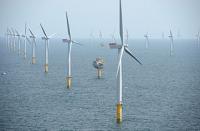
“Overall we see a great future for offshore wind in the UK for the right type of projects,” a DONG Energy spokesperson told Renewable Energy World. “At DONG Energy we currently have four projects under construction in the UK, which will provide another 2.7 gigawatts of offshore wind power.”
2016-08-19 Nuclear accident in New Mexico ranks among the costliest in U.S. history

When a drum containing radioactive waste blew up in an underground nuclear dump in New Mexico two years ago, the Energy Department rushed to quell concerns in the Carlsbad desert community and quickly reported progress on resuming operations.But the explosion ranks among the costliest nuclear accidents in U.S. history, according to a Times analysis. The long-term cost of the mishap could top $2 billion, an amount roughly in the range of the cleanup after the 1979 partial meltdown at the Three Mile Island nuclear power plant in Pennsylvania.
2016-08-18 Time to listen to the ice scientists about the Arctic death spiral

2016-08-04 Is China's Role in a UK Nuclear Plant Really a Cybersecurity Risk

While the government did not give a specific reason for the hold-up, one reason suggested is that it has reservations over China’s role in the construction. The state-owned China General Nuclear Power Corporation has agreed to a 33 percent stake in the project, and some suggest that the new British government may be concerned about the cybersecurity of the plant. Nick Timothy, Prime Minister Theresa May’s chief of staff, has previously said that experts think the Chinese government could use its involvement to introduce vulnerabilities into systems, which would allow it to tamper with Britain's energy production in the future.
2016-07-19 Offshore wind powers ahead as prices drop 30% below nuclear

The cost of offshore wind power in the North Sea is 30% lower than that of new nuclear, writes Kieran Cooke - helped along by low oil and steel prices, reduced maintenance and mass production. By 2030 the sector is expected to supply 7% of Europe's electricity.
2016-07-18 Fukushima reactor makers not liable: Japan court

A Japanese court on Wednesday turned down a class action lawsuit seeking damages from nuclear plant makers Toshiba, Hitachi and GE over the Fukushima meltdown disaster, the plaintiffs, one of the companies and a report said. About 3,800 claimants in the suit, hailing from Japan and 32 other countries including the United States, Germany and South Korea, had sought largely symbolic compensation from the nuclear power plant manufacturers.
Under Japanese liability law, nuclear plant providers are usually exempt from damage claims in the event of an accident, leaving operators to face legal action. The plaintiffs' lawyers, however, had argued that that violated constitutional protections on the pursuit of happy, wholesome and cultured livelihoods.
2016-05-14 British share of renewables setting records (24.7 % of Electricity)

A provisional estimate from the British government shows the amount of electricity generated from renewable energy set a record last year.
A monthly update from the British Department of Energy and Climate Change finds the share of electricity generated from renewable energy was a record 24.7 percent last year, which marked an increase of 5.6 percent from the previous year.
On a quarterly basis, the DECC said fourth quarter data show the share of renewables increased year-on-year by 5 percent.
"The increase reflects increased capacity, particularly in solar photovoltaics and onshore and offshore wind," the government's report said.
2016-04-20 Vestas tests four-rotor concept turbine
It is set to become a blueprint for larger-scale future products for specific markets, and the company plans to test core scaling rules, risks and opportunities, and transport and installation challenges in new markets.
2016-03-17 Koide Hiroaki: an insider's exposé of the Fukushima nuclear disaster

Koide Hiroaki has spent his entire career as a nuclear engineer, and has become a central figure in Japan's movement for the abolition of nuclear power plants.
Recent articles
2024-07-12 The Road to Net Zero Can Save Government Funds
Action Government SavingRemove government funding of Sizewell C, SMR, ANF and FNEF £ 1155 millionRemove government funding of nuclear fusion Up to £ 650 million to 2027Remove tax relief for the oil and gas industry Up to £ 5.7 billion/y from 2022 to 2025Remove government funding of CCS £ 20 billion over 20 years from 2023Remove government funding of imported biomass for Drax etc £ 606.8 million in 2022Total of above About £ 8.6 billion a year2024-10-12 A Note on Climate and Energy
I watched videos on climate change by Professors Johan Rockstroem and Stefan Rahmsdorf of the Potsdam Climatological Institute in Germany.This prompted me to create the document ‘2024-10-12 A Note on Climate and Energy’.2024-09-17 Britain’s Atomic Bomb Scandal (Channel 4 programme)
Channel 4 made a multi-part series of programmes with this title.The sub-title was: The dramatic, shocking story of Britain’s race for the nuclear bomb, the devastating fallout for the servicemen at the tests, and the veterans’ long fight for justice'. I watched all the parts, and made notes.Then I typed up the notes and followed up mentions and links to produce this document.2021-09-29 Nuclear Power and the EU Taxonomy
Around September 2021, the European Commission considered the inclusion of nuclear power in the taxonomy for future investments in energy. This was based on a single report from the European Joint Research Centre, which still has close links with the nuclear industry and is widely perceived as playing a promoting role for nuclear energy within the European Union. The JRC Report ignored the report of the German Ethics Commission for a Safe Energy Supply of 2011, which had lead to Germany phasing out nuclear power by 2023. The European Commision also ignored 'Sustainability at risk, A critical analysis of the EU Joint Research Centre technical assessment of nuclear energy with respect to the "do no significant harm" criteria of the EU Taxonomy Regulation, of 2021-09 by Dr. Christoph Pistner, Dr. Matthias Englert and Dr. Ben Wealer, for the Heinrich Boell Foundation.2023-06-06 Nuclear Power Has No Future
The UK government proposes to build nuclear power plants totalling 24 GW.This implies Hinkley Point C, Sizewell C and about six more of similar size.The Labour party proposes to include nuclear power in it’s new ‘green’ energy policy.Yet nuclear power has no future, as shown in this document of 3 pages with 52 references. The first section shows that nuclear fuel may be effectively exhausted before 2050, when the climate targets should be met. The second section shows that the costs of nuclear power have risen over time, and are now uncompetitive. So nuclear power must be replaced by sustainable and affordable options such as energy savings and renewables like wind, solar and storage. The third section shows that nuclear power conflicts with energy savings and renewables, so impairing the business case and deterring investment.So the UK should phase out nuclear power and join the rest of the world in deploying energy savings and renewables.Although this document is published after the latest Government and Labour Party proposals,I have published many earlier documents on nuclear power, dating from 2006-0-19. (See below).Most notably, my report on the Fukushima disaster was published on 2012-04-11, with copies sent to several MPs and Ministers.2022-10-05 Nuclear Nonsense
The new UK government appears to support the previous government’s proposal of building new nuclear power plants. The Labour party proposes to include nuclear power in it’s new ‘green’ energy policy. However such nuclear proposals are nonsense, as shown in this 4-page due diligence assessment.2022-08-12 Stopping Sizewell C and all nuclear power in favour of a rational energy policy
Among the last acts of the Johnson government was the approval of a new nuclear plant - Sizewell C. The claim was that it would increase energy security and reduce carbon emissions. But the invasion of Ukraine has underlined that all nuclear sites are targets, and reduce national security. Also nuclear power would be far more costly than energy savings and renewable energy sources such as wind and solar, with storage, and could not be generating electricity before 2030. They need uranium for fuel, yet almost half comes from Russia and Kazachkstan, so that the money and carbon costs would increase twice as fast. Moreover, they require huge amounts of energy to manufacture and build, so reducing energy security until construction is complete, and this energy repaid. Yet Hinkley Point C and Sizewell C are coastal sites, at risk from flooding by sea level rise and storm surge by 2100. As decommissioning and site clearance would take at least 50 years, they would need to be shutdown before 2050. Many reasons for stopping Sizewell C and all nuclear power are given in this collection of five documents.2022-08-13 Nuclear Power And Weapons Are Killing Us
The Manhattan Project in the US covered every stage of the production of nuclear weapons. This included the mining and refining of uranium, enrichment to 80 to 90% U235 for uranium bombs, fuelling nuclear reactors with uranium to produce plutonium, and reprocessing the spent fuel to extract the plutonium for plutonium bombs. It was recognised from the beginning that these processes and plants would give rise to radioactive releases that would be harmful to the plant operators and the general public, yet they were never informed. This continues to the present day, when the nuclear weapon and power industry does everything in its power to deny and understate the many and extensive harms done to all living things. To this has been added the use of uranium in bunker-breaking bombs and tank-busting shells, that spread the dust so formed over their own forces, the enemy forces, and innocent bystanders, harming them all for generations to come. The human harms include many and extensive cancers, and also non-malignant diseases such as stillbirths, deformities and mental impairment and heart disease. With so much harm already done to humans that will take up to lifetimes to express, and so much nuclear debris laying in wait to harm even more humans, it is essential to identify every strategy and measure that can reduce the total harm.This document covers the first warnings of nuclear harms in the 1950s and - following studies beginning in the 1960s - five books of evidence by Dr Ernest Sternglass in 1981, Mr Harvey Wasserman et al in 1982, Dr John Gofman in 1990, Mr Paul Zimmerman in 2009, and Professor Chris Busby et al in 2010.2022-06-14 Energy Transition Technologies
This is prompted by the Energy Hierarchy of the Institution of Mechanical Engineers. From the most to the least sustainable, Tier 1 is Energy Demand Reduction, Tier 2 is Energy Efficiency, Tier 3 is Utilisation of Renewable, Sustainable Resources, Tier 4 is Utilisation of Other, Low-GHG-Emitting Resources, and Tier 5 is Utilisation of Conventional Resources as we do now.2022-06-18 Nuclear Insecurities
This is a three-page re-cast of 2016-08-09 Nuclear Insecurities (below).It includes 16 criteria under the original 10 headings, supported by 21 references.
